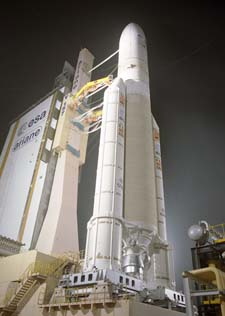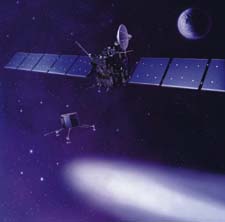
This high-performance Ariane 5 launch vehicle can place a 10-ton payload into geostationary orbit. Unfortunately, the rocket's inaugural flight, on December 12th, ended in failure when a serious malfunction occurred about three minutes after liftoff.
Courtesy ESA/CNES/Arianespace (Service Optique).
Mission managers at the European Space Agency abruptly postponed the launch of ESA's Rosetta spacecraft on January 13th, leaving the future of this ambitious project uncertain. The delay resulted from the loss of an Ariane 5 ECA rocket during its inaugural voyage on December 12th, which destroyed the two communications satellites it was carrying to orbit.
A review panel has begun analyzing the failure, but it is uncertain why the rocket malfunctioned — speculation has oscillated between a failure of the main rocket motor and a leak in its cooling system. Since an older model of the Ariane 5 was to be used to fling Rosetta toward its rendezvous with the periodic comet 46P/Wirtanen, the European Space Agency and Arianespace (the rocket's manufacturer) agreed that the risk to the billion-dollar Rosetta mission was too serious to proceed.
The comet-chaser was due to launch from Kourou, French Guiana, on the night of January 12th. Rosetta's short launch window to reach Comet Wirtanen directly will close by the end of the month, but dynamicists are exploring possible trajectories that include a flyby of Venus first. Alternately, a replacement comet may be required, but in that case the 2,900-kilogram Rosetta spacecraft would have few possible rendezvous targets. Those include the short-period comets Churyumov-Gerasimenko, Kopff, and Tempel 2, according to NASA dynamicist Don K. Yeomans (Jet Propulsion Laboratory). Each candidate comet must also produce a flurry of dust and gas for Rosetta's payload to gather accurate data.
"It's easiest to rendezvous with comets that have orbits similar to Earth's — which means no high inclinations and no high eccentricities," says Yeomans. "Identifying a comet for a flyby would be easy, but a rendezvous is much harder — it takes longer to get there. It may take up to 2½ years to find a new launch opportunity."

An artist's impression of the Rosetta spacecraft and its lander approaching Comet Wirtanen in 2011. Rocket problems delayed the mission's scheduled liftoff on January 12th, forcing European space planners to find a new target for their flagship mission.
Courtesy European Space Agency.
Although disappointed by the prospect of a long delay, European participants remain optimistic. "We are confident that this mission will fly to an alternative but equally interesting target," comments Richard Wade, program director for the United Kingdom's Particle Physics and Astronomy Research Council, once ESA managers conduct a "thorough and rigorous analysis of the whole situation."
The Rosetta mission, consisting of a large "mother ship" and an instrumented lander, represents ESA's most ambitious solar-system undertaking to date. By analyzing a comet firsthand with cameras, spectrometers, and other sensors, researchers hope to answer fundamental questions about the origin of our solar system, such as whether life on Earth was spawned by a chance encounter with a comet brimming with prebiotic organic compounds.
 0
0
Comments
You must be logged in to post a comment.